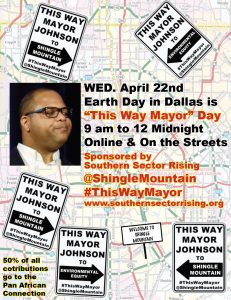Posts by jim
Don’t Miss the Big Searchlight Finale Tonight; Stand with Southern Dallas
Mayor Johnson is still a No-Show
At Shingle Mountain today
So we’re leaving the lights on to help him find us tonight
The company we’re renting these searchlights from promised a 25-mile view radius.
Help us learn if we got our money’s worth. Let us know if you can see it from where you are tonight and if you can,
take a picture and post it on
our FaceBook Event feed
Tonight’s light show is the big finale to our day-long action to help Dallas Mayor Eric Johnson find his way to Shingle Mountain and Environmental Equity.






Besides looking for our searchlights tonight, you can also…
1. Adopt a sign to help
Mayor Johnson Find His Way
We’re putting up 200 of these signs all over town. Want one near you? All you have to do is contribute what you can at our secure pay portal here, and make a request for a sign at the bottom of the form.
You can track where signs are popping up on this live Google map.
 Find one, take a sign selfie and send it in.
Find one, take a sign selfie and send it in.
Thanks.
2. Send a Letter To Mayor Johnson To Help Him find His Way to Shingle Mountain and Environmental Equity
Our ClickNSend letter app takes all of 30  seconds, allows you to add your own message, and tells Mayor Johnson and Dallas City Hall you support Environmental Justice. Thanks
seconds, allows you to add your own message, and tells Mayor Johnson and Dallas City Hall you support Environmental Justice. Thanks
3. Help us pay for these darn signs and searchlights.
We wanted to do justice to both the issues in Southern Dallas and the 50th Anniversary of Earth Day. If you think we succeeded please consider a contribution through our secure pay portal to offset the costs of a more memorable Earth Day 2020. Thanks.
Follow us on Facebook
Til Midnight:
#ThisWayMayor
Earth Day is “#ThisWayMayor Day” in Dallas
Unique Earth Day Protest Spotlights Mayor’s Indifference to Southern Dallas’ “Pre-Existing Conditions”
Connecting COVID to People of Color, 200 Street Signs Posted, Searchlights turned on to Show Mayor the Way to Shingle Mountain and Real “Equity”
FOLLOW US LIVE AT https://www.facebook.com/events/173129143854665/?active_tab=discussion
(Dallas) – A local group is using the 50th anniversary of Earth Day to chide Dallas Mayor Eric Johnson for what it says is his disregard for Southern Dallas’ “pre-existing conditions,” including the on-going public health threat of Shingle Mountain, the City’s largest illegal dump.
“We’re giving the Mayor the benefit of the doubt,” said Allen McGill, Co-Chair of Southern Sector Rising, a group borne out of the Shingle Mountain fight. “We’re assuming he hasn’t visited or said anything because he’s having trouble finding the place. We’re going to help him.”
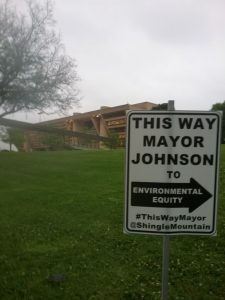 Beginning this morning and continuing throughout the day members of Southern Sector Rising are putting up over 200 “street signs” throughout Dallas politely but repeatedly pointing the Mayor In the direction of Shingle Mountain and “Environmental Equity” in English and Spanis
Beginning this morning and continuing throughout the day members of Southern Sector Rising are putting up over 200 “street signs” throughout Dallas politely but repeatedly pointing the Mayor In the direction of Shingle Mountain and “Environmental Equity” in English and Spanis
In addition, four-foot high block letters spell out “WE CANT BREATHE” from the summit of Shingle Mountain itself and two giant portraits of the Mayor have been glued to the gates of the site to help get his attention. Beginning at 8 pm tonight four giant searchlights will be turned on at Shingle Mountain to help guide him should he want to make the trip after dark.
All of this will be logged online in real time during the day at the group’s social media pages, including a Facebook event page where you can sponsor a “THIS WAY MAYOR JOHNSON” sign for your own residence or business and post “sign selfies.” Although the effort is tongue-in-cheek, McGill said organizers are deadly serious about pointing out Johnson’s inattention to the fundamental inequalities symbolized by the 100,00 ton, six-story high Shingle Mountain, now in its third year of posing an on-going public threat to adjacent residents.
Organizers say despite being invited and his administration’s adoption of “equity” as a governing principle, Mayor Johnson has never visited Shingle Mountain, never spoken publicly about it, and never addressed city government failures that allowed it to happen. They say he’s refused to order air monitoring for the site, refused to declare it a public health emergency, or waive the city’s landfill fees to help dispose of the waste. They see the City working to get money from bankrupt operators in court, but not protecting residents’ health and property rights in Southern Dallas. “Mayor Johnson’s and City Hall’s priorities are backwards” said McGill.
Supporter Fatima-Ayan Hirsi noted official disregard for inequities in code enforcement, 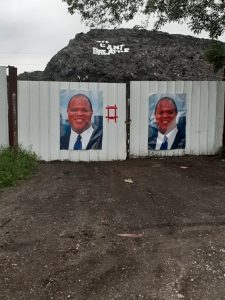 zoning, and housing result in worsening health conditions affecting Southern Dallas residents year-round while also putting them at higher risk of contracting the COVID 19 virus.
zoning, and housing result in worsening health conditions affecting Southern Dallas residents year-round while also putting them at higher risk of contracting the COVID 19 virus.
“ Racism created a set of “pre-existing conditions” that puts Black and Brown populations at a disadvantage before they even leave their homes. We hear a lot of rhetoric about “equity” from Mayor Johnson. We don’t see him trying to bring it to places like Shingle Mountain.”
A University of Texas Health Sciences Center map published in Mid-April shows the great majority of zip codes hosting 1-3 major risk factors for spread of the COVID virus are located in Southern Dallas, including the one Shingle Mountain is in.
An early April study from the Harvard School of Public Health found a connection between small increases in Particulate Matter (PM) air pollution and sharp increases in COVID mortality rates. Even a tiny increase in this type of air pollution can trigger a 20% increase in virus fatalities. Southern Dallas has been a battleground of fights against PM polluters, including four proposed batch plant permits in the last two years. Two of Dallas’ largest PM air polluters, the TAMKO and GAF asphalt shingle plants, are located in the middle of residential neighborhoods in Joppa and West Dallas respectively. Most of the City’s heavy industry is in Southern Dallas and the Trinity River floodplain.
McGill and Hirsi both dismissed the idea that the pointed challenge to the Mayor was unfair under the current circumstances. “COVID makes our actions today even more relevant and important,” said McGill. “If you don’t eliminate the Shingle Mountains, you can’t eliminate the slower-moving public health disasters, much less opportunistic pandemics. The Mayor must show some leadership.”
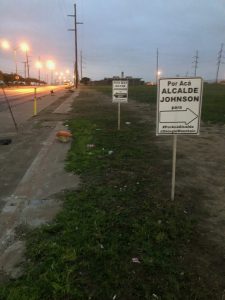 Southern Sector Rising is donating half of whatever it raises through its street sign sponsorships on Wednesday to The Pan African Connection bookstore and community center. Since 1989, Pan African has supported Black businesses and become a cultural and community crossroads in Southern Dallas. McGill called it a “grassroots institution that’s very important to Black Dallas and Dallas as a whole.”
Southern Sector Rising is donating half of whatever it raises through its street sign sponsorships on Wednesday to The Pan African Connection bookstore and community center. Since 1989, Pan African has supported Black businesses and become a cultural and community crossroads in Southern Dallas. McGill called it a “grassroots institution that’s very important to Black Dallas and Dallas as a whole.”
Hirsi was careful to explain the protesters all observed social distancing and group meeting guidelines implemented by state and local governments in planning and executing the action. For her, overcoming these logistical obstacles to pull off the most spectacular local Earth Day action in years makes the protest even more remarkable. “Because of the restrictions on movement, a lot of organizations are sponsoring digital-only Earth Day events. We wanted to do something more memorable no one expected on behalf of people who need their voices heard right now. We think we succeeded.”
Memo: Vote on Dallas Climate Plan Scheduled for May 27th…via Zoom?
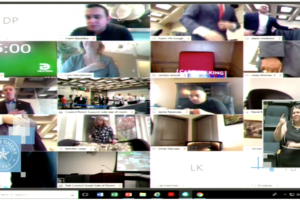 Disregarding calls to postpone a vote on its controversial Climate Plan until the Dallas City Council can resume traditional public participation in meetings, Council Environmental Chair Omar Narvaez has set a May 27th date for full council approval.
Disregarding calls to postpone a vote on its controversial Climate Plan until the Dallas City Council can resume traditional public participation in meetings, Council Environmental Chair Omar Narvaez has set a May 27th date for full council approval.
According to an April 9th memo Narvaez sent to the rest of the Council, the newest draft of the plan will be unveiled online on April 21st with a full briefing to the Environmental And Sustainability Committee scheduled on May 4th if that’s possible. If not, the full council will get a briefing on either May 6th or 20th.
While current local Shelter-in-Place orders expire at the end of April, most experts believe those should be extended through May and there’s no timeline for reinstating in-person public meetings of any local city councils or other governing bodies. If the City follows Narvaez’ schedule, it’s uncertain under what circumstances the Dallas Plan would be adopted, and how much public participation would be allowed.
That Dallas’ plan might be approved while by-passing the usual democratic niceties is just one more way it’s managed to elude real public engagement and transparency over the past two years. From beginning to end, the project has been a consultant and staff-led exercise with just enough of a thin veneer of “public participation” to reassure the unaware.
[pdf-embedder url=”https://www.downwindersatrisk.org/wp-content/uploads/2020/04/CECAP-memo_040910.pdf” title=”CECAP memo_040910″]
In the memo, Narvaez goes to great lengths to recap City Hall’s efforts at including “the public” in the plan. He cites the plan’s Stakeholder process, where staff hand-picked its own City Hall-friendly review committee. Not cited is the strange fact that there’s never been a list of individual stakeholder participants released and anyone wanting to know who was representing “the public” in the process had to submit an Texas Open Records Act request to City Hall to find out. Navarez also recounts the previous briefings his Committee has received from staff – but not the fact that no public participation was allowed in those briefings.
Neither does Narvaez mention that some of the Plan’s own official stakeholders are in open rebellion over its uninspiring results, including allies who were practically embedded with city staff for months. There are at least two separate on-going efforts by former stakeholders to try and strengthen the Plan before passage.
But the same divisions that have plagued Dallas environmental groups since the Plan’s announcement are dividing it at the end of the process as well. Representatives of larger mainstream groups like the Sierra Club and Public Citizen are pushing for quick adoption of the Plan, while Texas Campaign for the Environment, the local fledgling Sunrise Movement chapter, and others are seeking delay until citizens are allowed to come back into the Council Chambers and speak directly to their representatives – without the help of Zoom.
One recent development of the Plan that could be actually be relevant for ordinary residents is talk about restoring the Environmental Health Commission as a way to monitor the Climate Plan’s progress as well as serve as a new forum for residents’ concerns. Eliminated ten years ago just as secret gas drilling deals were being written by then City Manager Mary Suhm, the Commission had previously acted as the Council’s eyes and ears on all things related to public health and successfully advanced policy on a variety of fronts, including practical elimination of all waste incineration in Dallas.
Downwinder allies in The Southern Sector Rising Campaign for Environmental Justice called for restoration of the Environmental Health Commission last year at its March 20th news conference at City Hall and has been lobbying to bring it back ever since. Responding to a 2019 Dallas Green Alliance questionnaire, 10 of 15 current Council Members approved of the idea, so theoretically at least, it might be an easy sell.
If restoration of the Commission as previously fully empowered were to actually be included in a final Climate Plan package, at least something of practical real word use would have been purchased with the $500,000 + spent to date on the effort.
Our past coverage of the plan:
February 2019: “All Plan, No Action: Dallas City Hall’s Approach to Climate Change”
March 2019: “Dallas Climate Plan’s ‘Public Participation’ is Neither Very Public nor Participatory”
May 2019: “Dallas’ Climate Plan Rolls Out Public Engagement Plan. Public is MIA.”
November 2019: “The Only Thing Missing in Dallas’ Climate Plan “Focus on Equity” is…any measure of Equity”
February 2020: “How the Dallas Climate Plan Baits and Switches on Air Pollution”
March 2020: “Biggest Disappointment of the Dallas Climate Plan? Greens Giving Away Their Power For So Little in Return.“
Biggest Disappointment of the Dallas Climate Plan? Greens Giving Away Their Power For So Little in Return.
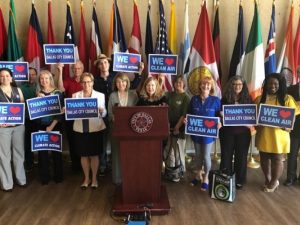
Who could have possibly foreseen? Many of the activists in this 2018 picture who lead the effort to secure half a million dollars for consultants to write a climate plan are now unhappy with the climate plan the consultants wrote. Photo by Linda Hamilton
There’s a lot of angst and disappointment among Dallas green groups over the draft of the consultant-driven Dallas Climate Plan released a couple of weeks ago and headed to a final vote in April.
Despite Mayor Mike Rawlings vowing to “adopt, honor, and uphold the commitments to the goals enshrined in the Paris Agreement” in 2017, the actual 2020 plan achieves less than 50% of the emission reduction goals by the deadlines set in that international agreement.
Since its unveiling, local green discontent with the Plan has been bubbling up in a variety of ways. There’s an appeal to join a protest rally at this Tuesday’s official roll-out of the Plan at the City’s day long “climate symposium” to show support for a “stronger,” and “better” plan. Another group’s online plea states that “many” of the Plan’s 93 action items are “inadequate” and not immediate enough. There are lists of demands that include the commitment to actually fund the recommendations proposed, accelerate vehicle and fleet electrification by a decade or more, and “more quantifiable actions” to insure the city meets its own goals.
What makes these criticisms both sad and instructive is that they’re coming from some of the same green groups that literally went door-to-door in 2018 trying to effusively sell Dallas residents on the idea of the consultant-driven climate plan they’re now faulting. Having campaigned and won City Council approval to spend $500,000 of the $750,0000 in earmarked “environmental funding” leftover from the city’s short-lived plastic bag fee, they were rewarded for that sales job by having their representatives appointed official “stakeholders” in the plan’s drafting.
That’s apparently all they got from the City for their effort. Because those representatives are now stoking the newfound discontent with the plan they presumably helped draft.
Was it naive of these groups to put their trust in the same City Hall that approved illegal gas drilling, Joppa batch plants, and Shingle Mountain? Undoubtedly. The largest disappointment with the Dallas Climate Plan isn’t the action items it does or doesn’t include, but the blank check of support it got from those who had the leverage to ask for more at the beginning of things. At exactly the time when they had the most real power to produce a more creative, effective Plan, they said no thanks and gave all the power to City staff and the consultants whose pay they had secured. That’s the original sin from which all other shortcomings flow.
Confronted with the City’s intent to create its own climate plan after Rawlings made that very public promise in 2017, a more successful effort might have tried to assemble some kind of Dallas Green Alliance-type response from the widest possible spectrum of groups, many of whom are experts in their respective interest areas – Urban Ag, Water, Solid Waste, Transportation, Environmental Justice, and Air Quality.
Despite the diverse interests, maybe it would have been possible to wrangle a grassroots residents’ plan that identified 1 to 3 make-or-break reforms or procedures out of a longer list of recommendations. At that point, with most green local groups on the same page about what they wanted from the plan, this coalition could have said to City Hall “If you want our support for that half million in consultants fees you have to promise X, Y, and Z be included in the adopting resolution.”
There are no guarantees such a path would have produced a better plan, but the tragedy is that it was never even tried.
All the original cheerleaders seemingly just wanted to cut a deal for a climate plan in name. For the most part, that’s exactly what they got. The only ones who seem surprised by its lack of serious content are the ones who signed-off on that superficiality.
Instead of building on reforms already negotiated up front, critics are now left to complain from the sidelines at the last minute, only weeks before the final vote. That’s rarely a recipe for successful change.
After Tuesday’s rollout, it looks like the full council might be briefed by staff on the Plan Wednesday, April 15th, with a symbolically-laden vote on the 50th anniversary of Earth Day, Wednesday April 22nd. Amendments are possible but need eight votes to pass a city council that has yet to be tested for its green bone fides.
Other “interest groups” have accumulated, organized, and leveraged their power to insure they weren’t cut out of the action at City Hall – the amazing LGBTQ Stonewall groups who are a force of nature in local politics, black and brown business associations, church and civil rights groups, and of course developers and the Citizens Council.
Some future Earth Day you’ll know the DFW green movement will have grown into a mature political force when it has the self-interest, wherewithal, and ambition to negotiate from a position of collective power. For now, among the costs we incur by the absence of that strategy are disappointing, timid climate plans.
Want to learn more about the Dallas Climate Plan process? Read our coverage:
February 2019: “All Plan, No Action: Dallas City Hall’s Approach to Climate Change”
March 2019: “Dallas Climate Plan’s ‘Public Participation’ is Neither Very Public nor Participatory”
May 2019: “Dallas’ Climate Plan Rolls Out Public Engagement Plan. Public is MIA.”
November 2019: “The Only Thing Missing in Dallas’ Climate Plan “Focus on Equity” is…any measure of Equity”
February 2020: “How the Dallas Climate Plan Baits and Switches on Air Pollution”
College of Constructive Hell-Raising Back for Class of ’22
 Civil Rights legend Peter Johnson talking community organizing with this year’s class.
Civil Rights legend Peter Johnson talking community organizing with this year’s class.
There might be no better symbol of Downwinders’ transformation from a local clean air group to Something More than our successful College of Constructive Hell-Raising.
After pausing in 2021, we’re preparing to begin a new and improved curriculum for the Class of ’22. The application to apply is at the bottom of this description.
Unlike other seminars for political activists that examine electoral strategies or specific skills like public speaking or fundraising, the College encourages its participants to “think like an organizer.” Its sessions are a combination of the same principles taught to professional organizers at the nation’s oldest schools of community organizing and the local DFW history of effective social change as told by the people who made it.
Environmentalism is not its focus. Rather it’s a deep dive into the mechanics of how “Davids” beat “Goliaths.”
Guest lecturers include original Southern Christian Leadership Conference (SCLC) organizer Peter Johnson, who knew MLK Jr. on a first name basis, as well as other well-known local legends John Fullinwider, Changa Higgins, Mavis Belisle, Sister Patricia Ridgley, Kim Batchelor, and Luis Selpulveda.
 As impressive as our speaker line-up is, it’s also the diversity of students who’ve fueled the success of the class – urban aggies, animal rights and police brutality activists, peace and immigration activists, LGBT, transit rights and anti-gentrification activists.
As impressive as our speaker line-up is, it’s also the diversity of students who’ve fueled the success of the class – urban aggies, animal rights and police brutality activists, peace and immigration activists, LGBT, transit rights and anti-gentrification activists.
We’ve have over 50 graduates, many of whom occupy positions of responsibility in social change groups throughout DFW. We’re growing a network of relationships that transcend single-issue silos and connect us to larger struggles through our philosophy of how things get done.
Interested? Another class begins January 2022 with enrollment beginning in October. You can put your name on a waiting list to get an early heads-up here, and follow the College on FaceBook here.
The Particulars
WHEN & WHERE
Class meets every other Tuesdays from January to May 7 – 9 pm.
COST
The cost is $150. It includes two books, and lots of reading material. Some half and full scholarships are available.
EARLY REGISTRATION: Sign-up more than 90 day before class and and the cost is $90.
ATTENDANCE POLICY
There are only 10 sessions. Absences are costly to you and your classmates. We understand our location makes it harder for those living and working outside metro Dallas to attend, but that’s why we start at 7 pm. Make sure you allow for DFW traffic in order to arrive on time. If you miss more than three classes, you’re welcome to keep attending classes but you will not graduate.

Class Schedule
Session One: “What is Constructive Hell-Raising?”
Introduction
Session Two:
Organizing Lesson: “The Four Dirty Words of Organizing”
Guest Lecturer: Peter Johnson, The SCLC and the First Fair Park Fight
Session Three:
Organizing Lesson: “(Internal) Organizing”
Guest Lecturer: John Fullinwider, Community Organizing in Old East Dallas’ with the Bois D’arc Patriots
Session Four:
Organizing Lesson: “Strategy vs. Tactics”
Guest Lecturers: Kim Batchelor, Mavis Belisle and Patricia Ridgley, The Anti-Nuclear Movement in Texas
Session Five:
Organizing Lesson:“(Self) Critical-Thinking”
Guest Lecturer: Luis Sepulveda, Getting the Lead out of West Dallas
Session Six:
Organizing Lesson: “Perception is Everything”
Guest Lecturers: TBA

Session Seven:
Organizing Lesson: “Ways of Seeing”
Guest Lecturer: TBA
Session Eight:
Organizing Lesson: “Outreach”
Guest Lecturer: Marsha Jackson, Cleaning-up Shingle Mountain
Session Nine:
Organizing Lesson: “Means vs Ends”
Guest Lecturer: Changa Higgins, Creating the Dallas Police Community Police Oversight Board
Session Ten:
Organizing Lesson:“The Qualities of a Good Organizer”
GRADUATION

Guest Lecturers
Kim Batchelor
Bois D’arc Patriot, tenant’s rights and immigration organizer
Mavis Belisle
Veteran DFW peace and anti-nuclear organizer
John Fullinwider
Longtime community organizer and original Bois D’arc Patriot
Peter Johnson
Former MLK Jr associate, original Dallas SCLC organizer
Sister Patricia Ridley
Life-long social justice worker based in Dallas, with emphasis on Central American and immigration rights
Luis Sepulveda
West Dallas environmental justice organizer who won clean-up of lead smelter waste
Changa Higgins
Community Police Oversight Coalition
Administration
Jim Schermbeck, Dean of Instruction
Jim Schermbeck has been a professional community organizer in DFW since 1989 when he opened the Dallas office of the National Toxics Campaign. He’s currently Director of Downwinders at Risk.
Downwinders At Risk, Board of Trustees
Downwinders at Risk is perhaps the most successful grassroots environmental group in Texas history. It’s certainly one of the most persistent.
Founded in 1994 to stop the burning of hazardous waste in Midlothian cement plants, it broadened its mission in 2010 to include protection of DFW air quality when it won its original fight. In 2017 it turned its focus on Particulate Matter air pollution and environmental justice.
Since its founding, Downwinders has used basic community organizing strategy to win its victories. Now we share what we’ve learned with other North Texas activists who want to increase their understanding of community organizing techniques, as well as learn about DFW social justice history.
Alumni Include:
Rachel Albright, Tarrant Transit Alliance
Kim Aman, Program Director, Moss Haven Farms
Clarice Criss, National Democratic Party campaign consultant
Paul Dill, Dallas Peace and Justice Center
Kristian Hernadez, DSA North Texas Co-Chair
Susie Marshall, Executive Director, GROW North Texas
Evelyn Mayo, Chair, Downwinders at Risk
Michelle McAdam, Economic Empowerment Specialist, New Friends New Life
Misti O’Quinn, North Texas Organizer, Sierra Club Beyond Coal
Jennifer Rangel, Inclusive Communities Project
Cory Troiani, DFW Program Director, Texas Campaign for the Environment
Michelle Villarreal, Major Gift Officer, ACLU Dallas
Student Comments :
“It made me move away from thinking of myself as an activist – someone who subscribes to a particular set of beliefs or positions, but doesn’t necessarily push forward a policy or action. Now, I think of myself as someone who has the tools to translate opinions into action. Now, I’m concerned with being effective, not just being right.”
“The information and knowledge gained from the College is invaluable for anyone at any stage of outreach, political gaming, activism, or simply in business or life.”
“The College is the best way to learn about historic progressive battles in Dallas, connect with a diverse group of committed citizens, and learn how to be a pragmatic, effective organizer.”
“I didn’t anticipate how quickly I would become informed on the history of progressive politics in Dallas; I didn’t anticipate getting to meet so many incredible organizers in the city (both lecturers and students).”
The depth of the class, as well as the opportunities to actually discuss and learn from those “in the trenches” and behind the scenes of significant events of the past couple of decades. It was invaluable seeing the different strategies and techniques used to accomplish goals.
“…the camaraderie and connections with other local activists that, despite my extensive network, I had never met before, was immeasurably important to the work I’m currently doing and plan to do in the future.”
“The level of insight that Jim has from his years of organizing was invaluable and very well organized/structured. The resources, thoughts behind each class topic, and chance to both connect with fellow aspiring organizers and meet/network with veteran difference-makers more than met what I was hoping for this course.”
“I absolutely loved your class and feel like I still touch on so many aspects of the things we learned. Now that I work at the ACLU of Texas, I feel like your class was the most valuable training I received in prep for this work. I’ll recommend your class because I feel like your class offers such a diverse range of experiences, resources, and lessons. I also just found out that they did not know about Peter Johnson’s work and he alone is a reason to join your class.”
COLLEGE APPLICATION FORM
Neighbors Hold First Meetings to Reverse Racist Zoning In the Shadow of Shingle Mountain
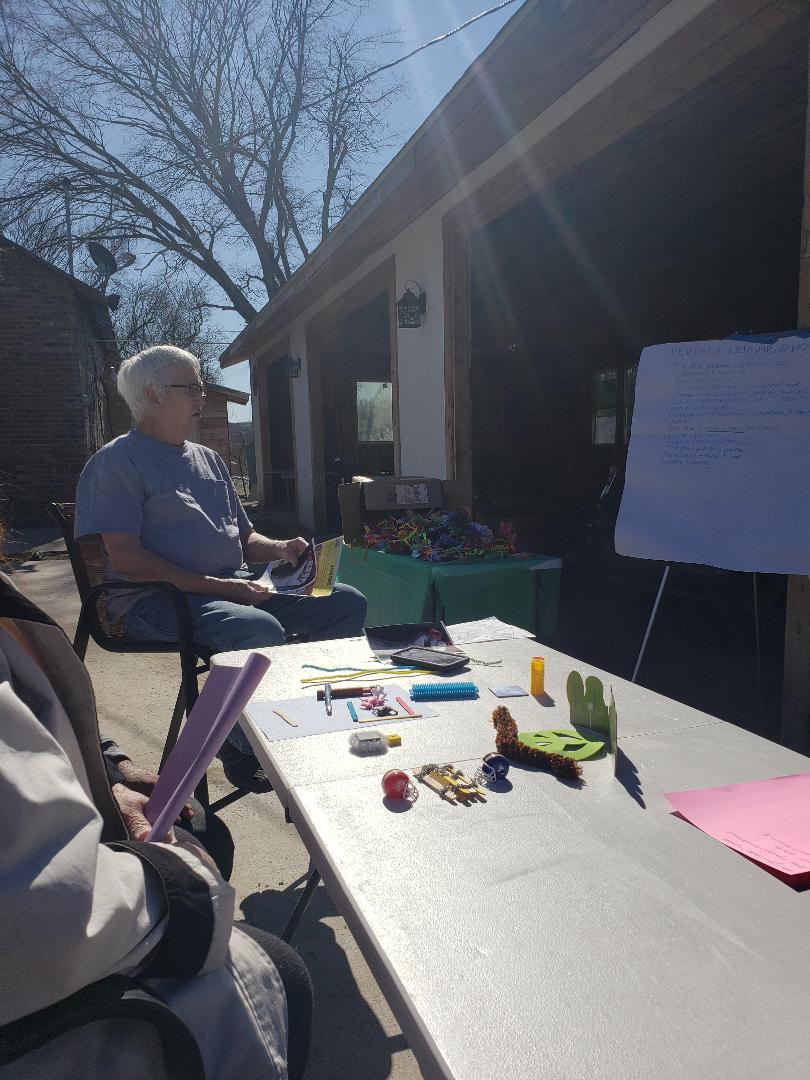 Gathering in an outdoor pavilion only feet away from the notorious Shingle Mountain, the illegal dump’s neighbors recently began to hammer together a very different future for what they want their community to look like.
Gathering in an outdoor pavilion only feet away from the notorious Shingle Mountain, the illegal dump’s neighbors recently began to hammer together a very different future for what they want their community to look like.
Using Legos, pipe cleaners, and construction paper Neighbors United members built a 3-D version of their new vision as part of the first wave of meetings in preparation for the upcoming “forwardDallas!” land use planning process.
Facilitated by The Inclusive Communities Project’s Jennifer Rangel and Downiwnders’ Chair Evelyn Mayo, the group was following up on its successful petition for “Authorized Hearings” to trigger a reexamination of how every tract in their part of the “South Central Corridor” should be zoned. That petition is now winding its way through City Hall and the group’s recommendations will be critical in getting things changed.
Even as they continue to fight for a full-clean-up the residents are doing their best to make sure their neighborhood isn’t victimized again by unscrupulous grifters like Shingle Mountain’s Ganter brothers or the City of Dallas’ own neglect. Their taking their fate into their own hands, in this case, one Lego block at at time.
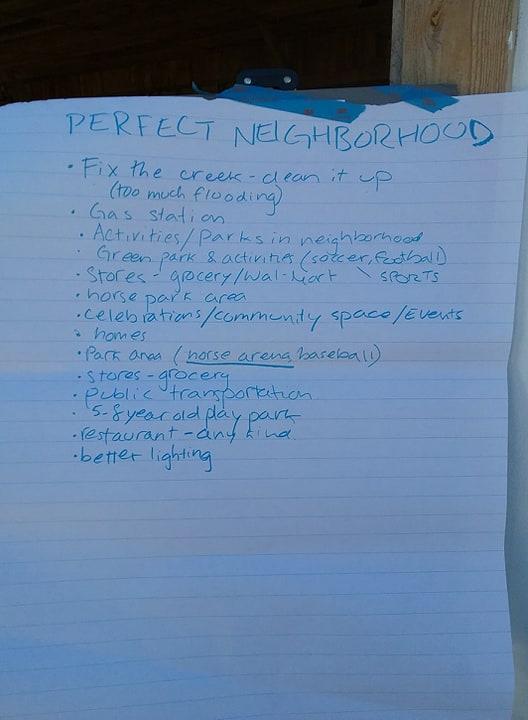
Last undertaken in 2009, “forwardDallas!” is a attempt to write a comprehensive plan for the entire city, block by block, that’s then (theoretically) referenced by residents, developers and City Hall planners in all future decisions. This time, there’s a grassroots campaign gearing up on behalf of environmental justice concerns in Southern Dallas using it to follow-through on previous promises to de-industrialize neighborhoods like Joppa and the South Central Corridors that are next door to the Great Trinity Forest but still dominated by heavy industry.
Obsolete racist zoning forces People of Color to live way too close to heavy industry polluters along the Trinity River floodplain. Success will mean undoing this kind of zoning in big chunks, improving public health and the chances of economic development in the process.
Important goals are restoring residency rights so everyone gets public notices, “down-zoning” tracts that aren’t being used by heavy industry now but could host them in the future, and pro-active pollution control measures new zoning could provide.
Zoning and land use decisions are a large reason why studies consistently show People of Color are exposed to more and higher levels of Particulate Matter air pollution than their white peers. Instead of continuing to battle Southern Dallas polluters permit by permit, zoning reform offers a way for residents to solve the underlying institutional problem. And because the “forwardDallas” review turbocharges the entire process, it offers the opportunity to make large gains faster.
Although the official start to “forwardDallas” isn’t scheduled until April now, Jennifer and Evelyn are getting a head-start so neighborhoods show up at the City meetings with something already in hand. If you’re interested in your neighborhood hosting one of their workshops, please contact us at: downwindersatrisk@gmail.com.
How the Dallas Climate Plan Baits and Switches on Air Pollution

A little after 5 pm Monday February 3rd, the Office of Environmental Quality and Sustainability (OEQS) at Dallas City Hall released its draft recommendations for the city’s climate “action” plan. There are 93 “action items” including transportation, buildings, green spaces, water management, solid waste, and urban agriculture. Most are without imagination or timelines, meaning that even the most milk toast-like recommendations being made will have to be fought for tooth and nail to be done in a timely manner.
Like the department that generated them, the list of recommendations is effusive about stormwater management and tree-planting and silent on more challenging issues such as inequitable pollution burdens and the City’s own reliance on natural gas. It once again puts the spotlight on the lack of any environmental health expertise at Dallas City Hall in the decision-making process. When Dallas OEQS staff talk about the environment, what they really mean is “conservation” – a definition that’s been obsolete since at least the 1970’s.
There’s no better example of how this tunnel vision affects policy than OEQS staff invoking DFW’s chronically poor air quality (i.e. an environmental health problem) to sell the need for its Climate Plan…only to see the actual Plan ignore poor air quality as a serious health issue that could use some innovative thinking.
For over a year now, anytime you saw a Climate Plan presentation by Dallas OEQS staff, it always cited DFW’s smog problem as something that would only get worse as the climate crisis played out. “Everyone here is probably aware of DFW’s longtime air quality problems” or some approximate was the standard riff. And of course, everybody was. Heads nodded. Audience members were sometimes asked if they knew anyone with asthma and hands immediately shot up. That was the point. The selling point.
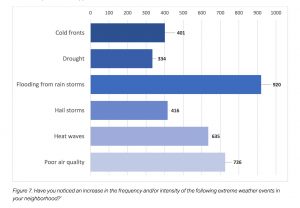 Because, until recently at least, the abstract nature of “the climate crisis” made it difficult to get people excited about the idea of a plan. Staff/Consultants needed a hook. And that hook was something everyone could relate to and probably already knew about: DFW’s three decades of violating the Clean Air Act. If you look at the results of the Ctiy’s online survey asking about frequency or intensity of climate change effects, “Poor Air Quality” was the second most cited concern. Among the City’s own handpicked crew of “stakeholders” advisors, it tied for first, along with buildings/energy use, getting more votes than parks, “nature-based approaches,” and renewable energy.
Because, until recently at least, the abstract nature of “the climate crisis” made it difficult to get people excited about the idea of a plan. Staff/Consultants needed a hook. And that hook was something everyone could relate to and probably already knew about: DFW’s three decades of violating the Clean Air Act. If you look at the results of the Ctiy’s online survey asking about frequency or intensity of climate change effects, “Poor Air Quality” was the second most cited concern. Among the City’s own handpicked crew of “stakeholders” advisors, it tied for first, along with buildings/energy use, getting more votes than parks, “nature-based approaches,” and renewable energy.
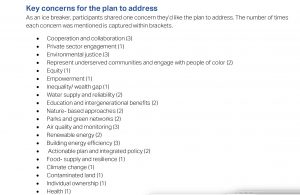
And yet, in those same City Staff presentations that highlighted poor air quality as a reason to have a Climate Plan, air quality itself was completely absent in the staff’s list of anticipated recommendations. It wasn’t that they just didn’t have much to say. They had nothing to say. There wasn’t even a category for air quality.
So Downwinders complained. Loudly. Staff and consultants sprang into action and came up with a category of recommendations officially called…“Other,” the theme of which was “air quality standards” and “public education.” Opportunities cited included “location-specific initiatives (e.g. downtown)” and “Programs targeted outdoor workers (e.g. Landscapers, construction workers).”
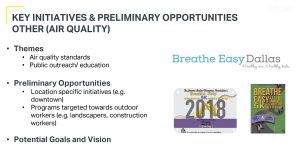 So sure, we have a chronic air pollution problem that warrants a $500,000 consultancy fee to construct a plan, but in that plan we’re only going to continue to inform people of that problem and maybe do some kind of vague thing relating to the poor souls who work outside (limit hours, hand-out free oxygen, help find new employment, or maybe free health check-ups? Doesn’t give a hint). By the way, only the public education part of that slide made it to last Monday. Construction workers and landscapers are still up a creek.
So sure, we have a chronic air pollution problem that warrants a $500,000 consultancy fee to construct a plan, but in that plan we’re only going to continue to inform people of that problem and maybe do some kind of vague thing relating to the poor souls who work outside (limit hours, hand-out free oxygen, help find new employment, or maybe free health check-ups? Doesn’t give a hint). By the way, only the public education part of that slide made it to last Monday. Construction workers and landscapers are still up a creek.
Along with those snippets of text on the “Other” slide were large color pictures of the “Breathe Easy” 5K run sponsored by The Jerome Alston Memorial Foundation in May…during Ozone Season. We’ll give the City staff credit. In terms of public education, there might not be a better way to personalize the seriousness of DFW’s air pollution problem than having North Texas smog cause an emergency asthma attack while you’re running in it. But liability could be an issue.
As late as the final round of public meetings last Fall, staff still didn’t have an “Air Quality” category but said they would have “something” when the plan was published.
Turns out “something” looks a lot like nothing.
Among the 93 “actions” listed in the Plan’s draft, the category of Solid Waste gets nine recommendations. Water Resources 15. Urban Ag 14. The brand new category of “Air Quality” has four – the fewest of any category in the plan. It’s practically stamping “Last-Minute Desperation” on the whole subject.
And tell us if any of these recommendations sound like anything you might have already heard about…
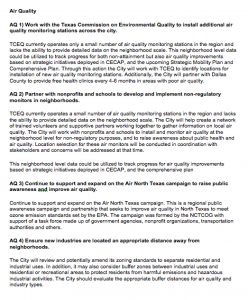
Let’s take them from the top.
The very first thing out of the gate, the lead-off, sexiest, out-of-the-box recommendation for improving air quality is…. somehow talk the State into adding more obsolete, state-run air monitors at some unspecified time in the future.
If you can, forget that the State environmental agency – the Texas Commission on Environmental Quality (TCEQ) – is a model for the Trump Administration. Forget that its official position is that smog is waaaaay overrated as a health threat. In other words, forget that this is akin to hiring Charlie Sheen to babysit your only child.
It’s not the baked-in, in-your-face cynicism of City staff knowing the state has every reason not to do this that’s so offensive. It’s the same cynicism applied to knowing full well what will happen even if the state says yes to the request: no real improvement in local information about air quality. Those state monitors are big, slow, and sparse. They run two hours or more behind real time. They’re hard to find online. They’re needlessly expensive and take up lots of real estate that has to be purchased. Their placement is decided by TCEQ and city staff, not the communities most in need of them. There is no stated OEQS goal for the number of monitors to acquire, or suggestions about where new monitors should be. No language in the recommendation about wanting real time monitoring or more modern equipment. It’s just an expansion of an already-obsolete system the state only runs because federal law requires them to (for now).
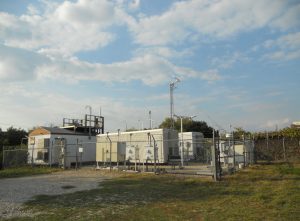
OEQS wants more of these lumbering and obsolete monitors from the state.
So let’s say the City talks the state into doubling the number of state PM 2.5 monitors in Dallas. Victory! The discussion will then be where to place the second slow, hard-to-find PM monitor for all of Dallas County’s 2.5 million residents.
Left unsaid in this recommendation is something we already know. For a year now Staff has tried to move that single Dallas County PM monitor located on Hinton Street north of Downtown to somewhere in Southern Dallas. Apparently the state has made that hard-to-impossible and so for the purposes of having something, anything, to recommend for this climate plan, staff recommends more monitors – knowing there’s a snowball chance in Hell of getting them. It’s the perfect bureaucratic out.
Most importantly the City remains a spectator to the reporting to its residents of how bad their air is. Its staff doesn’t have to make any environmental health judgments as they’re busy promoting tree planting. They leave that up to the people who couldn’t care less about how much pollution you’re breathing.
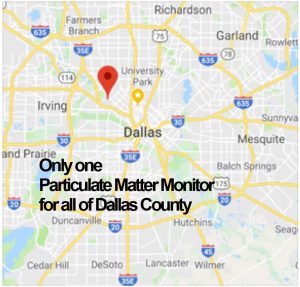
In the wake of recent Gulf Coast chemical plant accidents, the TCEQ is under heavy criticism for its lack of current air monitoring technology. The system it operates in DFW hasn’t changed in over 20 years. TCEQ won’t even put an air monitor in the only DFW “non-attainment” county that doesn’t have one – Wise – where smog levels have been predicted to be even higher than in DFW proper.
Recommending a modest expansion of circa-1999 technology is the opposite of a “best practices” answer for our gap in local air quality knowledge. The most alarming thing about this recommendation is that it got made at all.
The one-liner stapled at the end about offering free health screenings “with Dallas County” (who’s already in the business) in “areas with poor air quality” is incredibly condescending. Here’s the ultimate “settlement house” approach to a social ill – addressing the symptoms but not the cause. “Well, we can’t do much to enforce code or keep those batch plants out of your backyard, but by God we’ll be around every 6 months to keep track of your asthma until you die from it.”
How does OEQS staff know where those “areas with poor air quality” are now unless they’re out monitoring them? Which they clearly do not want to do. Given there’s only one official PM monitor for all of Dallas County, how are they defining “areas with bad air?” If they’re making educated guesses where those “areas” are based on other factors besides monitoring, why not name those factors and the “areas?” OEQS goes out of its way to avoid using the words “environmental justice” even as it makes recommendations based on the concept.
Recommendation #2 – let’s build our own “non-regulatory” air monitoring network sometime in the unspecified future with unspecified non-profits and community partner volunteers and put an unspecified number of monitors in unspecified places, for which we unspecified criteria. And these monitors “could be used to “to track progress for air quality improvements based on strategic initiatives deployed in CECAP, and the comprehensive plan.”
This is actually a great idea. It’s such a great idea that a specified alliance of local governments, non-profits, and community partners are already doing it in specified locations with specified monitors. Their effort is about to deploy over 100 locally-built air monitors that will increase PM 2.5 monitoring in Dallas County by 4000%. It’s called the SharedAirDFW Community Air Quality Monitoring Network and the City of Dallas officially walked out of it last year over a public participation requirement and a desire to refrain from being the source of bad news about bad air.
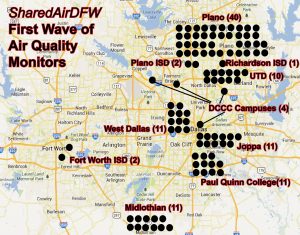
Dallas city staff is consistent in believing that telling you about air pollution is absolutely, positively necessary – they just want someone else to do it.
Having walked away from the SharedAirDFW network, OEQS set out to make one up of its own using the City Hall-friendly Nature Conservancy as its non-profit partner. The “Breath Easy” plan was to put 9-12 PM and smog monitors on the same number of DISD campuses, grow trees and implement anti-idling zones at those schools and see if asthma attacks/rates dropped in 24 months (2 growing cycles). Everyone seemed to agree how important a project this was and the city raised $500,000 or more to buy 12 very nice Aeroqual (Recommended by Downwinders since 2017!) air monitors. Everyone but the Dallas independent School District, who nixed the idea last summer. This detail somehow escaped the presentation staff gave to the City Council’s Quality of Life Committee on the Breath Easy project in September 2018.

An Aeroqual stationary air monitor like the 12 Dallas owns…but isn’t using
So far the City of Dallas is 0 for 2 in making their own recommendation a reality when it had the chance. But wait! Remember those 12 monitors the City bought for the defunct Breathe Easy project? They’re just sitting somewhere. They’re already paid for but aren’t being used. OEQS could implement this recommendation of theirs on its own tomorrow if it wanted to by placing these 12 monitors in locations based on where the most industrial facilities are and where the most air pollution complaints come from. Overnight it could have its own fleet of “non-regulatory” monitors in the field, with all the benefits cited by staff.
But there’s no mention of those 12 monitors, or of the City Hall’s ability to accomplish this goal on its own, right now, without waiting. Because it doesn’t want to. It wants someone else to do it.
Recommendation #3 . It’s that forlorn public awareness recommendation showing up in the form of continued support for an ozone season air quality campaign run by a group that did its part to make smog an issue for years. There’s no harm to this but there’s also no help. This campaign will go on for as long as DFW is in violation of the Clean Air Act and doesn’t mention climate change.
Finally, there’s recommendation #4. Perhaps (but perhaps not) heavy industry that pollutes a lot shouldn’t be close to homes. This is coming straight-faced from a OEQS that’s approved the last four batch plants seeking permits to set-up shop in Joppa and the South Central Corridor…next to homes. Do as we recommend, not as we actually, you know, do.
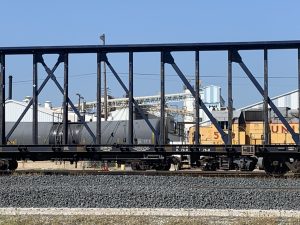
The TAMKO asphalt shingles plant and multiple diesel locomotives operate next to Austin’s asphalt batch plant…and residents in Joppa
When it says the City will review zoning, that’s not a special environmental health screening of sites. It’s just part of upcoming land use planning processes that will already be used to re-examine all zoning on a neighborhood-by-neighborhood level. They’re riding coat tails. The OEQS doesn’t make recommendations about suggested buffer zones, where those zones should be, or what criteria the city should use in pursuing buffer zones. And it doesn’t even say the City’s neighborhoods need any buffer zones between homes and industries at all, just that it may want to consider them at an unspecified time by an unspecified body for unspecified neighborhoods. Have we mentioned the staff at City Hall really really doesn’t like to deal with environmental health issues?
We get it. They had to have something or you’d be reading our criticism about the absence of ANY specific air quality recommendations, no matter how lame. And there are other items in other categories that will inevitably produce decreases in air pollution of all kinds – bus and vehicle fleet electrification being among the lowest-hanging fruit.
But City Hall’s cynical use of DFW’s air pollution problem to win support for a plan that ends up doing nothing about it directly makes these “Air Quality” recommendations particularly contemptuous.
What would more sincere “air quality” recommendations look like?
1. Acknowledging an historic imbalance in the air pollution burdens borne by Dallas neighborhoods and a commitment with a deadline to inventory the City’s air pollution threats by council district and zip code. You c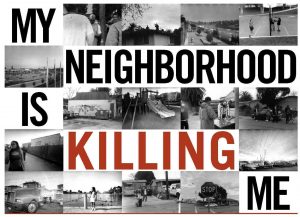 an’t fix what you don’t measure. Right now there’s no map of where concentrations of air pollution are in Dallas.
an’t fix what you don’t measure. Right now there’s no map of where concentrations of air pollution are in Dallas.
2. Acknowledging there’s no safe level of PM air pollution, i.e., no amount of exposure that isn’t capable of doing harm. Acknowledging People of Color are exposed to more, and higher levels of PM pollution than their white peers. These conclusions, supported by a multitude of good studies, including ones from EPA, are basic in prioritizing where to reduce air pollution in Dallas.
3. Recommendation to write an Environmental Equity Provision into City Code to discourage and prohibit siting new polluters in those zip codes hosting more permitted polluters than the citywide average, beginning in 2021.
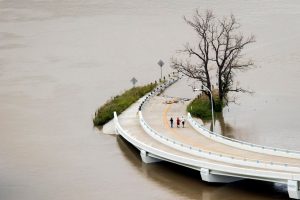 4. Recommendation to quit siting polluters in any floodplain beginning in 2021.
4. Recommendation to quit siting polluters in any floodplain beginning in 2021.
5. Recommend a 2025 deadline for the electrification of all railroad switch yard operations in Dallas.
6. Recommend 1500 foot buffer zones on either side of new major highways where homes, day care centers, and schools would be prohibited from locating. Applied to existing highways as uses within 1000 feet come up for new permits and zoning.

7. Recommend the immediate amortization and relocation of the GAF asphalt shingle factory in West Dallas and the TAMKO shingle factory in Joppa. These factories are among the City’s largest industrial polluters in Dallas, accounting for over 420 tons of air pollution in 2017 alone. They operate in the middle of dense urban residential areas populated primarily by People of Color. They need to be relocated elsewhere. Building new facilities will automatically trigger modern pollution controls requirements. They’ll be cleaner and doing business in a less harmful location.
8. Recommendation to rewrite city codes giving incentives for cleaner industries and more requirements for dirty ones.
9. Join UTD’s SharedAirDFW Community Air Monitoring Network – plug OEQS’ 12 unused monitors into the Network and begin to take responsibility for telling Dallas residents what their air quality actually is.
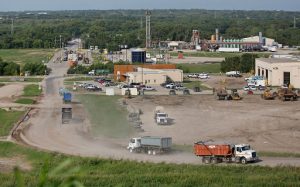 10. Acknowledge the conflict of interest the City has in producing and selling gas from its landfill recovery operation and commit to electrification of all city-owned vehicles by 2025. Dallas’ own city-run McCommas Bluff methane gas recovery facility is the fourth largest air polluter in Dallas, releasing over 160 tons of air pollution in 2017 alone. Recommend contracting only with electric vehicle fleets for additional services. Los Angeles recently committed to an all electric garbage truck fleet in five years, and Dallas could do the same – but it still wants to use its own landfill gas to power combustion vehicles.
10. Acknowledge the conflict of interest the City has in producing and selling gas from its landfill recovery operation and commit to electrification of all city-owned vehicles by 2025. Dallas’ own city-run McCommas Bluff methane gas recovery facility is the fourth largest air polluter in Dallas, releasing over 160 tons of air pollution in 2017 alone. Recommend contracting only with electric vehicle fleets for additional services. Los Angeles recently committed to an all electric garbage truck fleet in five years, and Dallas could do the same – but it still wants to use its own landfill gas to power combustion vehicles.
11. Implement stronger enforcement of the city air quality and nuisance ordinances, including hiring new staff and publicizing how to request an investigation.
12. Beginning in 2025 begin collecting municipal clean air mitigation fees of $50 a pound on permitted air pollution from major sources to incentivize pollution controls and pay for new staff. In 2017 such a fee would have collected over $1 million.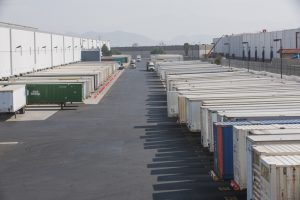
13. Implement no idling zones in all Dallas warehouse districts.
14. Recommend Low-Emission Zones in Downtown Dallas where combustion vehicles are banned or restricted, permanently or on a schedule. Consider expanding to other parts of Dallas such as Deep Ellum and Bishop Arts where congestion is already a problem.
15. Recommend PM pollution protection be designed into new bus shelters.
16. Recommend establishment of an Electric Bus Procurement Pool with DISD, DART, Trinity Metro, other area schools districts, and transit companies for cheaper purchases of electric buses.
17. Restoration of t he Dallas Environmental Health Commission.
he Dallas Environmental Health Commission.
18. Hiring a City of Dallas Environmental Health Scientist.
DFW does have a chronic bad air problem. The Climate Crisis will make it worse. It is a legitimate area of policy planning in any thoughtful, modern Climate Plan.
Just not this one.
Downwinders Welcomes New Board Members
November brought a round of new board members joining our ranks. It also brought an historic milestone. For the first time in our 25 year history, we’re now governed by a board whose majority is composed of people of color.
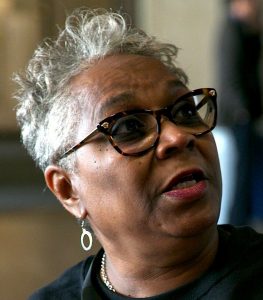 Marsha Jackson
Marsha Jackson
A year ago not many people at Dallas City Hall knew Marsha Jackson’s name. That’s not the case this December. Ms. Jackson is both the founder of her own neighborhood group, Neighbors United, and the citywide Southern Sector Rising Campaign for Environmental Justice. She’s also the nearest neighbor to Shingle Mountain, Dallas’ largest illegal dump and the highest profile symbol of environmental racism in North Texas since the RSR lead smelter clean-up in the early 1990’s. Like Luis Sepulveda almost 30 years ago Marsha Jackson’s name has become synonymous with the fight for Environmental Justice in Dallas.
Michelle McAdam
Michelle is a long-time friend of Downwinders who finally decided to join the board. She was a student in the very first year of our College of Constructive Hell-Raising, where she met her unlikely Southern Dallas doppelganger and provided us with one of our favorite college stories. She’s a true Daughter of Dallas nobility but instead of resting on our laurels or trust funds, she’s worked tirelessly her whole adult life for people who haven’t been as fortunate, including being on staff at the International Rescue Committee and now as an Economic Empowerment Specialist at New Friends New Life, a group working to transition women out sex trafficking or exploitation.
 Justina Walford
Justina Walford
Justina is a former District 4 City Council candidate, Southern Dallas dog rescuer and advocate, and member of the Southern Sector Rising Campaign Steering Committee. She’s also Director of the annual Women Texas Film Festival. Born and raised in Southern California, Justina owned a theater in Hollywood during the early 2000’s where she produced full length plays and storytelling events that included her original work.
Amber W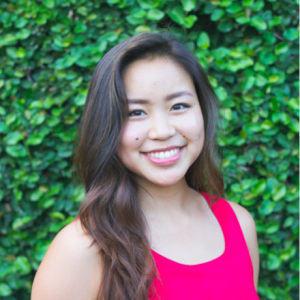 ang
ang
Amber has degrees from Rice in Mechanical Engineering and trouble-making from our own College of Constructive Hell-Raising. She’s Technology Manager at the Victory
Co-Working space Hatchways and has bravely decided to help us in developing more sustainable local funding source. At Rice Amber led a student design organization that developed pro bono solutions for nonprofit organizations and social ventures in the Houston community. We hope she can do the the same for us.
Downwinders And Southern Sector Rising Awarded Communities Foundation Grant for “forwardDallas!” Zoning Reform Campaign
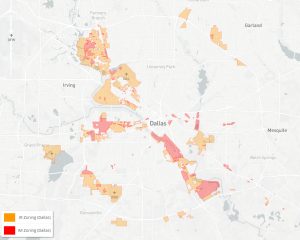
An important part of Downwinders’ 2020 agenda got a big boost this last month when we learned we’d received a $20,000 Communities Foundation of Texas grant to take on Dallas’ environmentally unsound and racist zoning as part City Hall’s upcoming “forwardDallas!” land planning process.
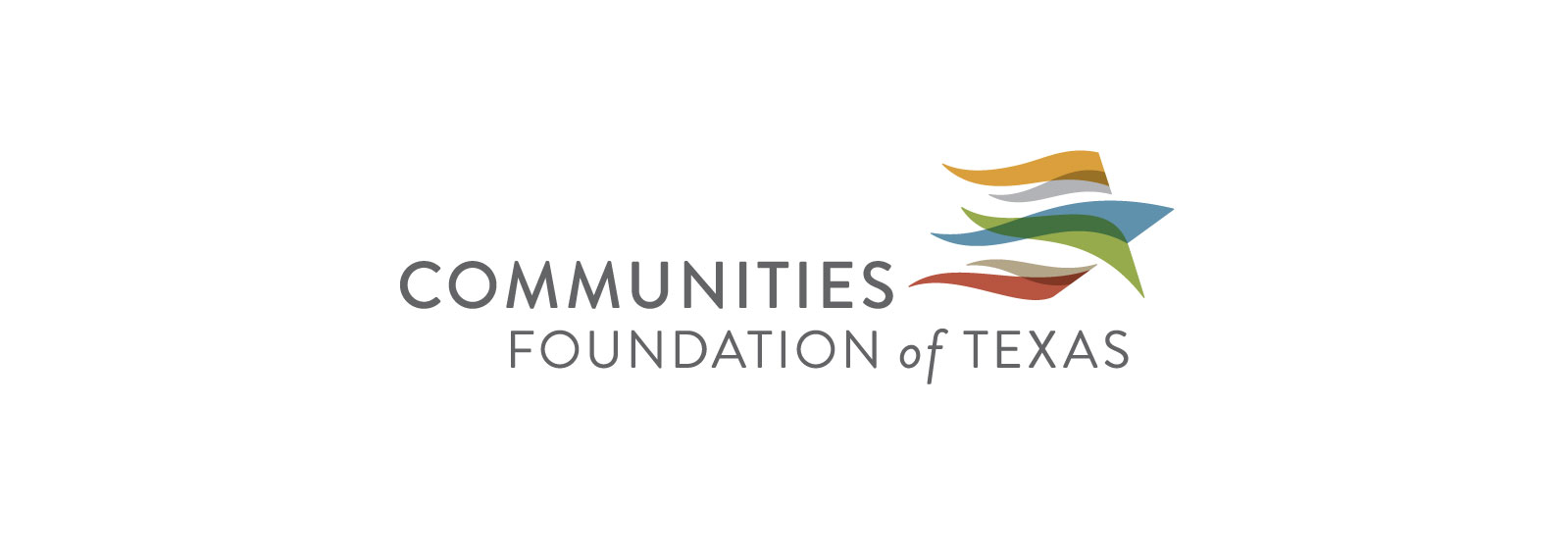 Touted as a meeting-intensive opportunity to reshape Dallas neighborhoods by the residents who live in them, the last time the city went through “forwardDallas!” was also its first time, in 2006.
Touted as a meeting-intensive opportunity to reshape Dallas neighborhoods by the residents who live in them, the last time the city went through “forwardDallas!” was also its first time, in 2006.
With our allies at the Southern Sector Rising Campaign for Environmental 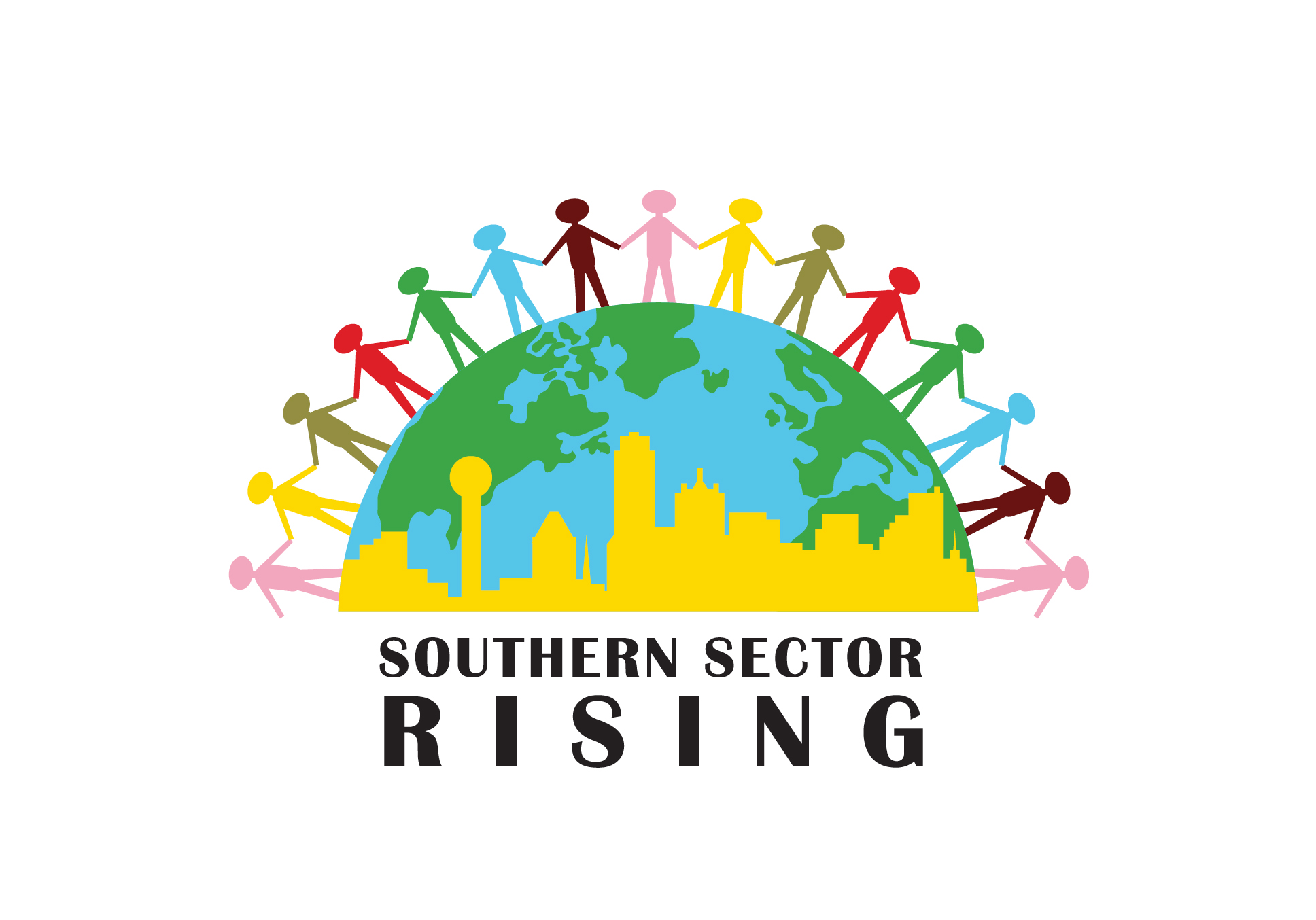 Justice, we proposed to use this new round of planning to reverse dangerously obsolete zoning in Southern Dallas where polluters are operating next door to homes, especially in predominantly black and brown neighborhoods like Joppa and West Dallas.
Justice, we proposed to use this new round of planning to reverse dangerously obsolete zoning in Southern Dallas where polluters are operating next door to homes, especially in predominantly black and brown neighborhoods like Joppa and West Dallas.
Employing the on-going Shingle Mountain scandal as a rallying cry, both groups see an opportunity to win real environmental justice progress if neighborhoods can be mobilized. Toward that end we’ll be engaging residents with door-to-door canvassing, neighborhood meetings, and appointments with officials from Pleasant Grove to West Dallas. Thanks to the Communities Foundation, we’ll be able to devote a sizable amount of resources to this campaign.
Working in our favor is the expertise of the recently-named “forwardDallas!” Chair District 11 Plan Commission Jaynie Schultz. Ms. Schultz earned an MA in Urban Studies from UTA, is Chair of the Plan Commission’s Urban Design Committee, and most importantly for this new assignment has been on the Plan Commission since 2014 consistently opposing the default dumping of new polluters in Southern Dallas in one battle after another.
Although this grant was written in part to help provide salary to our lone staff person, we’d really like to use the whole thing for program work. We can only do that if folks such as yourself respond with End-of-Year contributions and help us raise the $5-10,000 we need to pay the region’s only full time environmental community organizer.
Having the endorsement of the Communities Foundation is a huge plus for our local fundraising efforts and we’re very appreciative. Having your endorsement is even more important. Please help us stretch this grant. Thanks.
YES, I’LL HELP YOU MAKE THAT COMMUNITIES FOUNDATION GRANT GO FURTHER
First Regional Air Monitoring Network “Meet and Greet” in Joppa Draws Packed House and Volunteers
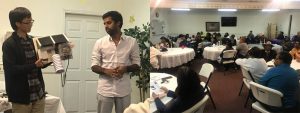
A new regional air quality network bringing 21st Century science to some of Dallas’ most polluted neighborhoods had it’s official coming out party on December 5th in the former Freedman’s community of Joppa.
A community meeting at New Zion Missionary Baptist Church sponsored by Downwinders at Risk in association with Paul Quinn College and Habitat for Humanity drew a standing room only crowd.
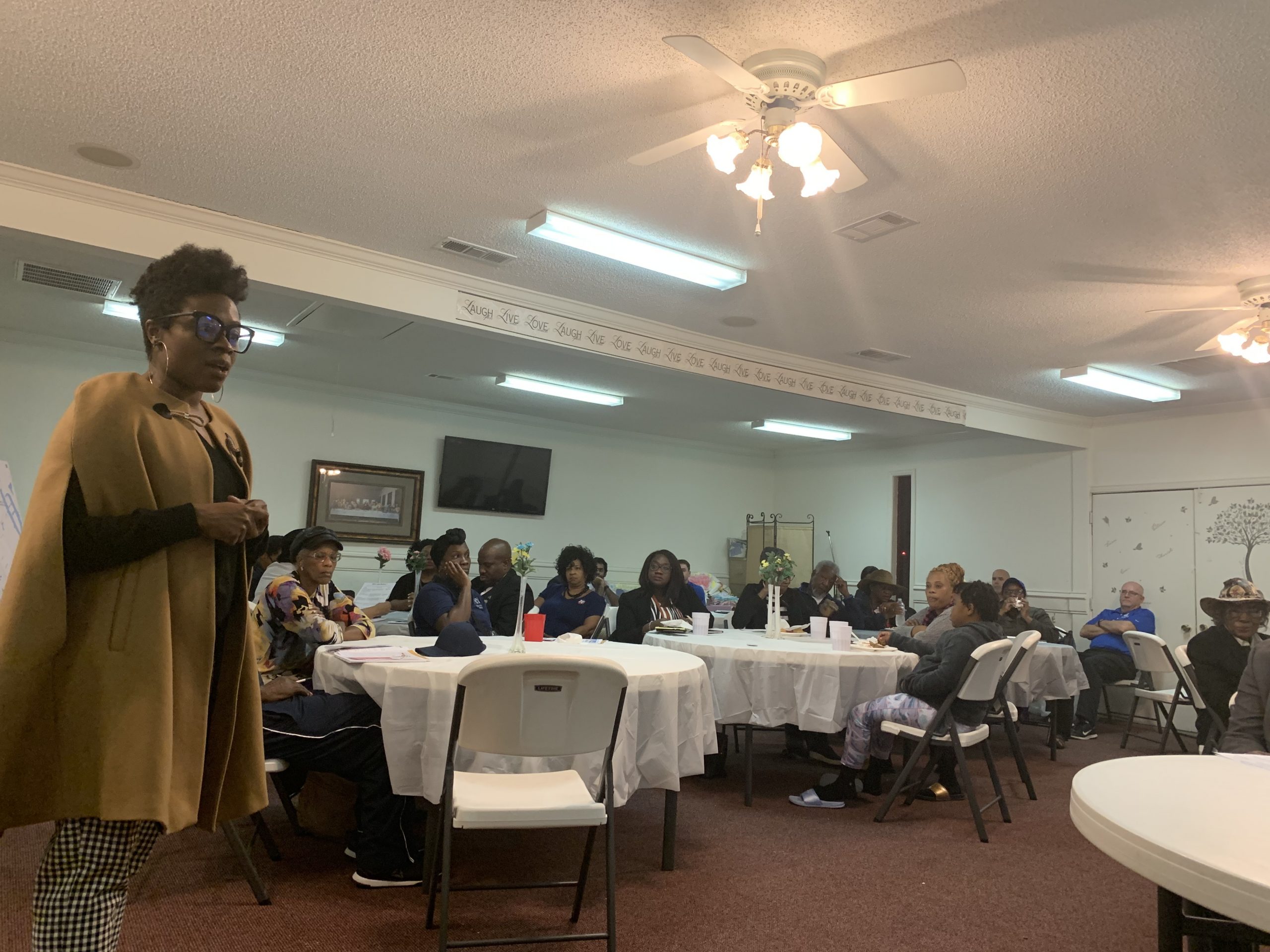 Food from Jason’s, door prizes, and the opportunity for a Parkland Hospital health screening made the meeting into a real community event.
Food from Jason’s, door prizes, and the opportunity for a Parkland Hospital health screening made the meeting into a real community event.
Residents got to see a monitor up close and hear a presentation by the University of Texas at Dallas graduate students building them for distribution over the next year. 11 of the monitors are due to be installed in Joppa, with another 11 installed in near-by Southern Dallas neighborhoods by Paul Quinn College. In total, over 100 are scheduled to be distributed from Plano to Fort Worth to Midlothian in the largest non-government network of its kind in Texas.
Joppa is surrounded by multiple sources of Particulate Matter air pollution, including a concrete batch plant, an asphalt batch plant, a Union Pacific railroad switch yard, Loop 12 and the Tamko asphalt shingle factory. Because of its compact size an relatively small population, it has the highest per capita air pollution burden in Dallas.
That’s why Downwinders chose to begin building its part of the network in Joppa. Thursday’s roll out was the first attempt to find hosts for the monitors among the neighborhood’s residents.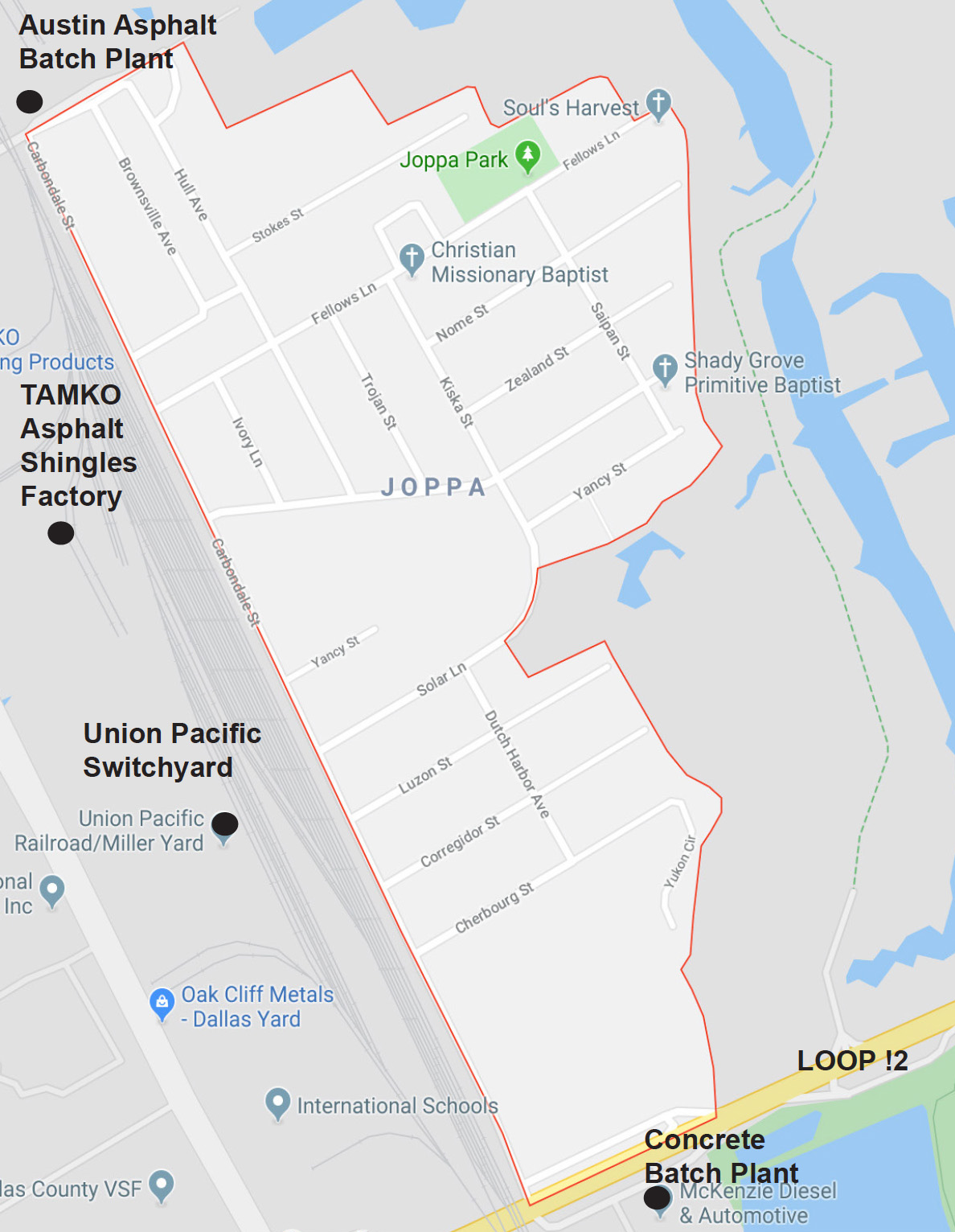
There were lots of questions and lots of enthusiasm. At least two Joppa residents didn’t need any more convincing and wanted to know how fast they could get a monitor at their house.
The answer is….soon. District 7 Council Member Adam Bazaldua is assisting the network in coordinating the electrical and internet connections we need for the “mothership” that carries the load for 10 smaller solar-powered and wireless sensors. A utility pole Downwinders bought from Oncor for that very purpose is only about 30 feet down the street road the New Zion Church where the meeting was taking place. All we need now are the connections.
Downwinders will be following up this meeting with door-to-door canvassing in Joppa and updates to everyone who signed-in. Meanwhile, we should be scheduling similar meetings in West Dallas and Midlothian after the first of the year.
After years of planning and preparation, we’re finally beginning to see the payoff of our vision. Thanks to all of our supporters for helping us achieve this first, but important milestone

